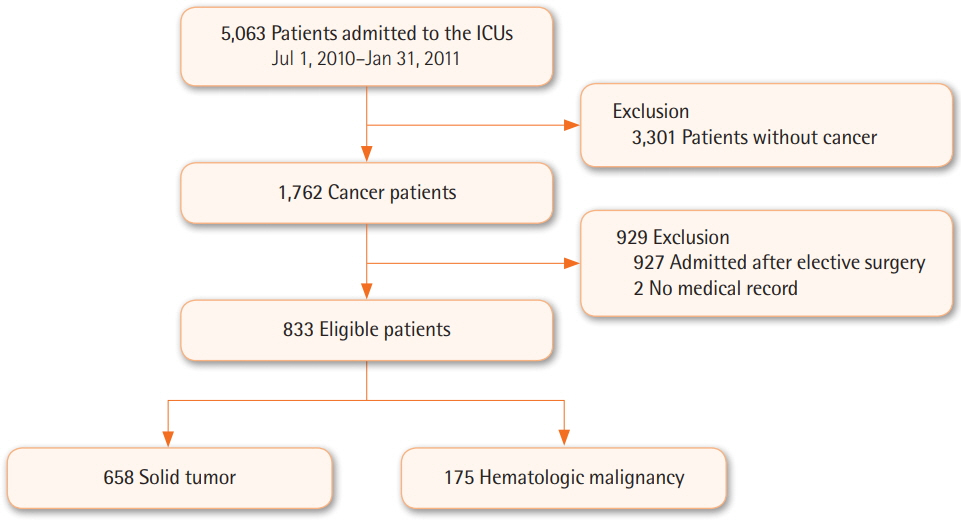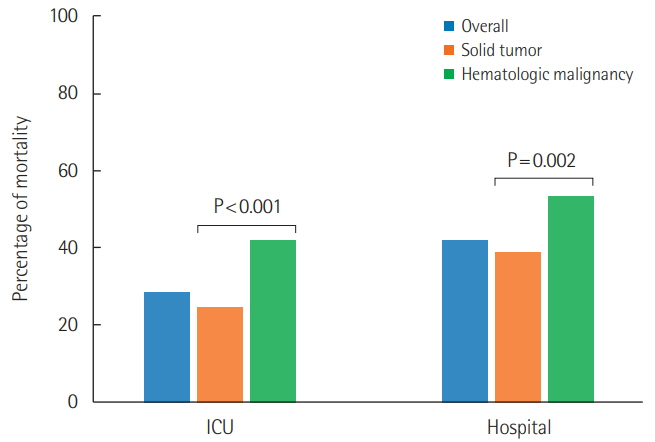Acute Crit Care.
2018 Aug;33(3):121-129. 10.4266/acc.2018.00143.
Characteristics and Clinical Outcomes of Critically Ill Cancer Patients Admitted to Korean Intensive Care Units
- Affiliations
-
- 1Department of Critical Care Medicine, Samsung Medical Center, Sungkyunkwan University School of Medicine, Seoul, Korea. kjeon@skku.edu
- 2Department of Surgery, Soonchunhyang University Bucheon Hospital, Bucheon, Korea.
- 3Division of Pulmonary and Critical Care Medicine, Department of Medicine, Asan Medical Center, University of Ulsan College of Medicine, Seoul, Korea.
- 4Division of Pulmonary and Critical Care Medicine, Department of Medicine, Samsung Medical Center, Sungkyunkwan University School of Medicine, Seoul, Korea.
- 5Department of Anesthesiology and Pain Medicine, Anesthesia and Pain Research Institute, Yonsei University College of Medicine, Seoul, Korea.
- 6Division of Pulmonary and Critical Care Medicine, Department of Medicine, Dongsan Hospital, Keimyung University, Daegu, Korea.
- 7Department of Anesthesiology and Pain Medicine, Ewha Womans University Mokdong Hospital, Seoul, Korea.
- 8Division of Pulmonary and Critical Care Medicine, Department of Medicine, Seoul St. Mary's Hospital, College of Medicine, Catholic University of Korea, Seoul, Korea.
- 9Division of Pulmonary and Critical Care Medicine, Department of Medicine, Chungju Hospital, Konkuk University School of Medicine, Chungju, Korea.
- 10Department of Critical Care Medicine, Korea University Ansan Hospital, Ansan, Korea.
- 11Division of Pulmonary and Critical Care Medicine, Department of Medicine, Chung-Ang University College of Medicine, Seoul, Korea.
- 12Division of Pulmonary and Critical Care Medicine, Department of Medicine, Gangneung Asan Hospital, University of Ulsan Medical College of Medicine, Gangneung, Korea.
- 13Department of Pulmonary, Allergy and Critical Care Medicine, Hallym University Sacred Heart Hospital, Anyang, Korea.
- 14Division of Pulmonary and Critical Care Medicine, Department of Medicine, College of Medicine, Gyeongsang Institute of Health Sciences, Gyeongsang National University, Jinju, Korea.
- 15Division of Pulmonary and Critical Care Medicine, Department of Medicine, Ewha Womans University School of Medicine, Seoul, Korea.
- 16Division of Pulmonary and Critical Care Medicine, Department of Medicine, CHA Bundang Hospital, CHA University, Seongnam, Korea.
- 17Department of Multimedia, Seoul Women's University, Seoul, Korea.
- 18Samsung Advanced Institute of Health Science and Technology, Samsung Medical Center, Sungkyunkwan University School of Medicine, Seoul, Korea.
- KMID: 2436323
- DOI: http://doi.org/10.4266/acc.2018.00143
Abstract
- BACKGROUND
The objective of this study was to investigate the characteristics and clinical outcomes of critically ill cancer patients admitted to intensive care units (ICUs) in Korea.
METHODS
This was a retrospective cohort study that analyzed prospective collected data from the Validation of Simplified Acute Physiology Score 3 (SAPS3) in Korean ICU (VSKI) study, which is a nationwide, multicenter, and prospective study that considered 5,063 patients from 22 ICUs in Korea over a period of 7 months. Among them, patients older than 18 years of age who were diagnosed with solid or hematologic malignancies prior to admission to the ICU were included in the present study.
RESULTS
During the study period, a total of 1,762 cancer patients were admitted to the ICUs and 833 of them were deemed eligible for analysis. Six hundred fifty-eight (79%) had solid tumors and 175 (21%) had hematologic malignancies, respectively. Respiratory problems (30.1%) was the most common reason leading to ICU admission. Patients with hematologic malignancies had higher Sequential Organ Failure Assessment (12 vs. 8, P < 0.001) and SAPS3 (71 vs. 69, P < 0.001) values and were more likely to be associated with chemotherapy, steroid therapy, and immunocompromised status versus patients with solid tumors. The use of inotropes/vasopressors, mechanical ventilation, and/or continuous renal replacement therapy was more frequently required in hematologic malignancy patients. Mortality rates in the ICU (41.7% vs. 24.6%, P < 0.001) and hospital (53.1% vs. 38.6%, P=0.002) were higher in hematologic malignancy patients than in solid tumor patients.
CONCLUSIONS
Cancer patients accounted for one-third of all patients admitted to the studied ICUs in Korea. Clinical characteristics were different according to the type of malignancy. Patients with hematologic malignancies had a worse prognosis than did patients with solid tumor.
Keyword
MeSH Terms
Figure
Reference
-
1. van Vliet M, Verburg IW, van den Boogaard M, de Keizer NF, Peek N, Blijlevens NM, et al. Trends in admission prevalence, illness severity and survival of haematological patients treated in Dutch intensive care units. Intensive Care Med. 2014; 40:1275–84.
Article2. Garrouste-Orgeas M, Montuclard L, Timsit JF, Reignier J, Desmettre T, Karoubi P, et al. Predictors of intensive care unit refusal in French intensive care units: a multiple-center study. Crit Care Med. 2005; 33:750–5.
Article3. Schuster DP, Marion JM. Precedents for meaningful recovery during treatment in a medical intensive care unit: outcome in patients with hematologic malignancy. Am J Med. 1983; 75:402–8.4. Jackson SR, Tweeddale MG, Barnett MJ, Spinelli JJ, Sutherland HJ, Reece DE, et al. Admission of bone marrow transplant recipients to the intensive care unit: outcome, survival and prognostic factors. Bone Marrow Transplant. 1998; 21:697–704.
Article5. Soares M, Caruso P, Silva E, Teles JM, Lobo SM, Friedman G, et al. Characteristics and outcomes of patients with cancer requiring admission to intensive care units: a prospective multicenter study. Crit Care Med. 2010; 38:9–15.
Article6. Azoulay E, Mokart D, Pène F, Lambert J, Kouatchet A, Mayaux J, et al. Outcomes of critically ill patients with hematologic malignancies: prospective multicenter data from France and Belgium. A groupe de recherche respiratoire en réanimation onco-hématologique study. J Clin Oncol. 2013; 31:2810–8.7. Torre LA, Siegel RL, Ward EM, Jemal A. Global cancer incidence and mortality rates and trends: an update. Cancer Epidemiol Biomarkers Prev. 2016; 25:16–27.8. Lim SY, Koh SO, Jeon K, Na S, Lim CM, Choi WI, et al. Validation of SAPS3 admission score and its customization for use in Korean intensive care unit patients: a prospective multicentre study. Respirology. 2013; 18:989–95.
Article9. Metnitz PG, Moreno RP, Almeida E, Jordan B, Bauer P, Campos RA, et al. SAPS 3: from evaluation of the patient to evaluation of the intensive care unit. Part 1: objectives, methods and cohort description. Intensive Care Med. 2005; 31:1336–44.10. Levy MM, Fink MP, Marshall JC, Abraham E, Angus D, Cook D, et al. 2001 SCCM/ESICM/ACCP/ATS/SIS International Sepsis Definitions Conference. Crit Care Med. 2003; 31:1250–6.
Article11. Oken MM, Creech RH, Tormey DC, Horton J, Davis TE, Mc-Fadden ET, et al. Toxicity and response criteria of the Eastern Cooperative Oncology Group. Am J Clin Oncol. 1982; 5:649–55.
Article12. Moreno RP, Metnitz PG, Almeida E, Jordan B, Bauer P, Campos RA, et al. SAPS 3: from evaluation of the patient to evaluation of the intensive care unit. Part 2: development of a prognostic model for hospital mortality at ICU admission. Intensive Care Med. 2005; 31:1345–55.13. Staudinger T, Stoiser B, Müllner M, Locker GJ, Laczika K, Knapp S, et al. Outcome and prognostic factors in critically ill cancer patients admitted to the intensive care unit. Crit Care Med. 2000; 28:1322–8.
Article14. Bos MM, de Keizer NF, Meynaar IA, Bakhshi-Raiez F, de Jonge E. Outcomes of cancer patients after unplanned admission to general intensive care units. Acta Oncol. 2012; 51:897–905.
Article15. Darmon M, Thiery G, Ciroldi M, de Miranda S, Galicier L, Raffoux E, et al. Intensive care in patients with newly diagnosed malignancies and a need for cancer chemotherapy. Crit Care Med. 2005; 33:2488–93.
Article16. Hawari FI, Nazer LH, Addassi A, Rimawi D, Jamal K. Predictors of ICU admission in patients with cancer and the related characteristics and outcomes: a 5-year registry-based study. Crit Care Med. 2016; 44:548–53.17. Chi AK, Soubani AO, White AC, Miller KB. An update on pulmonary complications of hematopoietic stem cell transplantation. Chest. 2013; 144:1913–22.
Article18. Pastores SM, Voigt LP. Acute respiratory failure in the patient with cancer: diagnostic and management strategies. Crit Care Clin. 2010; 26:21–40.
Article19. Bhatt V, Saleem A. Review: drug-induced neutropenia. Pathophysiology, clinical features, and management. Ann Clin Lab Sci. 2004; 34:131–7.20. Bodey GP, Buckley M, Sathe YS, Freireich EJ. Quantitative relationships between circulating leukocytes and infection in patients with acute leukemia. Ann Intern Med. 1966; 64:328–40.
Article21. Puxty K, McLoone P, Quasim T, Sloan B, Kinsella J, Morrison DS. Risk of critical illness among patients with solid cancers: a population-based observational study. JAMA Oncol. 2015; 1:1078–85.22. Depuydt PO, Benoit DD, Vandewoude KH, Decruyenaere JM, Colardyn FA. Outcome in noninvasively and invasively ventilated hematologic patients with acute respiratory failure. Chest. 2004; 126:1299–306.
Article23. Platon L, Amigues L, Ceballos P, Fegueux N, Daubin D, Besnard N, et al. A reappraisal of ICU and long-term outcome of allogeneic hematopoietic stem cell transplantation patients and reassessment of prognosis factors: results of a 5-year cohort study (2009-2013). Bone Marrow Transplant. 2016; 51:256–61.
Article24. Depuydt P, Kerre T, Noens L, Nollet J, Offner F, Decruyenaere J, et al. Outcome in critically ill patients with allogeneic BM or peripheral haematopoietic SCT: a single-centre experience. Bone Marrow Transplant. 2011; 46:1186–91.
Article25. Azevedo LC, Caruso P, Silva UV, Torelly AP, Silva E, Rezende E, et al. Outcomes for patients with cancer admitted to the ICU requiring ventilatory support: results from a prospective multicenter study. Chest. 2014; 146:257–66.26. Pène F, Aubron C, Azoulay E, Blot F, Thiéry G, Raynard B, et al. Outcome of critically ill allogeneic hematopoietic stemcell transplantation recipients: a reappraisal of indications for organ failure supports. J Clin Oncol. 2006; 24:643–9.
Article27. Soares M, Salluh JI, Spector N, Rocco JR. Characteristics and outcomes of cancer patients requiring mechanical ventilatory support for >24 hrs. Crit Care Med. 2005; 33:520–6.28. Peigne V, Rusinová K, Karlin L, Darmon M, Fermand JP, Schlemmer B, et al. Continued survival gains in recent years among critically ill myeloma patients. Intensive Care Med. 2009; 35:512–8.
Article



